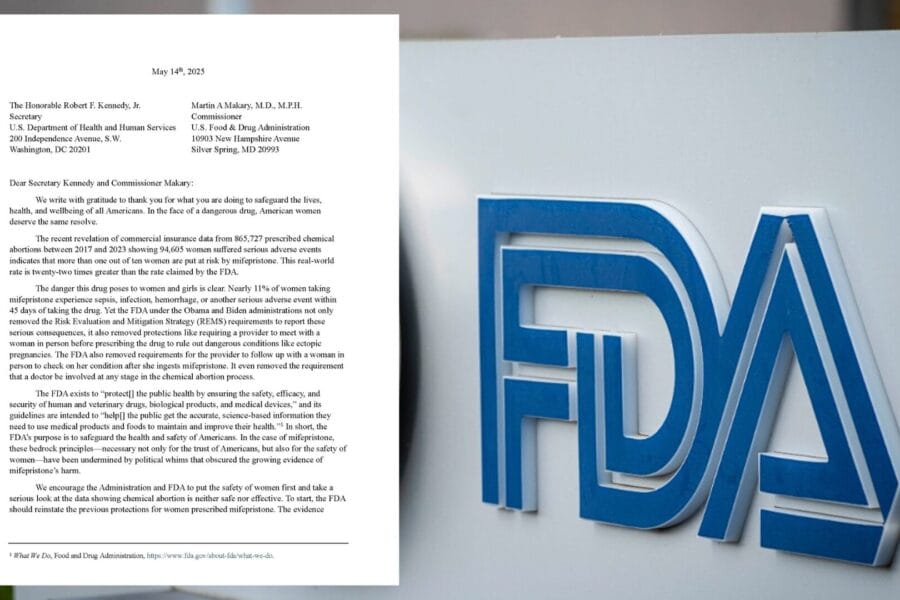On a few rare occasions in any given life, the American story truly changes: the fall of the Berlin Wall in 1989, the September 11, 2001, attacks, the two-year COVID pandemic—and on June 24, 2022, when the United States Supreme Court struck down Roe v. Wade after nearly 50 years of shoring up a regime of constitutionalized abortion and the unspeakably tragic loss of over 60 million human lives. “We hold that Roe must be overruled,” Justice Samuel Alito wrote for the Court. “The Constitution makes no reference to abortion, and no such right is implicitly protected by any constitutional provision…” Abortion, the Court declared, is “critically different from any other right that this Court has held to fall within the Fourteenth Amendment’s protection of ‘liberty’ … because it destroys what [Roe and Casey] call ‘fetal life’ and what the law now before us describes as an ‘unborn human being.’”
I’m sure you’ll always remember exactly where you were when you heard the news that the Court had finally submitted its resignation as the “National Abortion Control Board” by reversing Roe v. Wade and ending America’s tragic national abortion regime. On an ordinary day, I would have been in my kitchen making breakfast for my three children and planning a busy day at the office. But this particular day in June was different – I was on a layover in the San Francisco airport heading to a briefing for a faithful AUL partner when my phone dinged with a text from my family group chat: “Catherine, it’s been a really long fight and your efforts have been successful! We’re so proud of you and love you so much.” When I saw the Court’s announcement, in an instant, my memory flashed back to the child I lost to abortion many years ago and the lies the abortion business used to persuade me to make that awful decision. Then I said a prayer of deep gratitude for my tireless co-laborers for life on the staff of Americans United for Life, and the untold numbers of deeply devoted lawmakers, policy advocates, and supporters who for fifty years have refused to accept the verdict of a small number of black-robed men that women must have a right to destroy their children in the womb in order to achieve equality.
Millions of Americans are now asking incredulously, “What just happened?” But the downfall of Roe didn’t “just happen.” Many years ago, the late Supreme Court Justice Antonin Scalia lamented that “the edifice of abortion” the Court had erected “seemingly overnight” may have to be torn down “door jamb by door jamb” and never fully toppled over. The Pro-Life Movement took his words as a moral challenge, and won hard-fought battles in the Court which reduced Roe over decades to the Potemkin façade the Court finally pushed over this June. The abortion right that was proclaimed “fundamental” in Roe narrowly escaped being overruled nearly twenty years later in Planned Parenthood v. Casey, emerging as a mere “liberty interest” subject to the States’ authority to regulate it like any other medical procedure. Along the way, the movement secured victory after victory in the Supreme Court for the lives of women and children, ensuring that States could outlaw unlicensed “back-alley” abortionists, refrain from paying for elective abortions with taxpayer dollars, insist on the reporting of abortion data that documents just how risky the procedure is, and mandate that abortion doctors provide basic informed consent to their patients on what abortion really does to a vulnerable human being in utero. As Roe was being torn down, the Pro-Life Movement was rebuilding the system of strong legal protections for women facing abortion that the Supreme Court had nullified in one fell swoop. More victories came after Casey, most notably a ringing affirmation from the Court that some abortion procedures were too barbaric to permit. Criticism of Roe mounted both from the Court’s own Justices and from many appeals court judges. Meanwhile, the abortion rate dropped precipitously year after year—to the point where a woman today is only as likely to make that desperate choice as she was in 1972, the year before Roe v. Wade.
Here we are, then, essentially back to the beginning. As it was before Roe, some states will continue regimes of abortion on demand and pretend that they’re safeguarding a sacred right. Others will be enabled to implement strongly protective laws outlawing the practice and providing help and support to mothers facing unexpected pregnancies. Where abortion activists seek to enshrine a so-called “right to abortion” in state law or impose it from the benches of state judges, AUL and its partners in the Pro-Life Movement will be there to fight for life. Roe’s reversal is no mic drop moment. No one is talking about taking a victory lap and walking off into the sunset. After Roe, our work isn’t done; we’ll keep defending life until every precious human being is “welcomed in life and protected in law,” as AUL has affirmed for many years.
At Americans United for Life, we are “advancing the human right to life in culture, law, and policy.” We’ve experienced this unforgettable historic moment because of the result of the decades-long work of many thousands of heroic Americans in all three realms. Culture—which both shapes and is shaped by the law—has been moving toward rejecting abortion and embracing life for decades now. The law of abortion has at last, belatedly, caught up with the will of the American people in the Dobbs decision. Policy is simply the will of the people expressed through the state and federal lawmakers they elect. And policy has led the way in building a culture of life, with hundreds of pro-life bills passed in the last ten years—most of which AUL drafted and helped enact. After Roe, saving every innocent life and protecting all women from predatory abortion businesses has suddenly moved into the realm of the possible.
Consider this: after Roe, states have the constitutional authority to outlaw abortion at any stage of human life, including for the youngest and most vulnerable. No longer will lawmakers be able to duck and cover on the abortion question, claiming they’re “personally opposed to abortion” but that their “hands are tied” because of Roe. Every federal and state legislator will be directly accountable to the people who elected them for the decisions they make (or not) to protect life, and that will be a very good thing for the American body politic. In the wake of Roe, a thousand flowers will bloom to protect life: mothers will receive care from a constellation of pro-life pregnancy centers (which currently outnumber abortion centers five to one); states will ensure that alternatives to abortion are well-funded and promoted; and infants will be welcomed and cherished in life, as they should be. The American Life Initiative from Americans United for Life is our vision for the pro-life movement post-Roe. We look ahead to visionary culture, law, and policy solutions that will make possible a truly pro-life future by protecting all our citizens, including the very youngest and the mothers who bear them.
Consider also that after Roe, not only is there no longer any federal constitutional right to elective abortion, there is no federal interest in elective abortion. A slew of statutes passed by Congress since Roe have prohibited taxpayer funding for elective abortion, prevented federal facilities from being used for abortions, and stopped federal taxpayer dollars from promoting abortion at home and abroad. In fact, despite the protestations of the current presidential administration, after Roe the policy of the United States—expressed in its laws and administrative regulations—is to protect life and discourage abortion. It is a pro-life policy. Neither the Constitution nor federal statutes and regulations provide for a policy of protecting, funding, or supporting abortion. This opens up a whole host of opportunities for protecting life at the federal level, which the American Life Initiative explores.
The American Life Initiative also looks ahead to the Pro-Life Movement’s ultimate goal: the abolition of abortion. We cannot accept halfway measures, or a nation divided against itself over the “right” to destroy its own children. Abortion is incompatible with constitutional justice. We will continue to urge leaders at every level of government—executive, legislative, and judicial—to clarify that, because abortion violates natural human rights, no authentic constitutional order can persist alongside abortion violence. We will continue to encourage every leader to embrace the constitutional logic I outlined alongside Josh Craddock, J.D. and Chad Pecknold, Ph.D. in the Lincoln Proposal, namely that unborn children truly are, as a matter of constitutional justice, entitled to the equal protection of the laws. At the same time, Americans United for Life will continue to work for the day when America passes a 28th Amendment to the U.S. Constitution, clarifying for all time that abortion shall not exist within the United States of America.
Finally, we will need to think differently now about what it means to have a “culture of life.” As critically important as strong pro-life laws are, more is needed. For this reason, in addition to AUL’s annual Life List that surveys and ranks states based on how pro-life their laws are, in 2023 we will launch a new tool to gauge just how pro-life a state’s culture is—how strongly its citizens are determined to provide the means and the tools to equip women to succeed and embrace the lives they bear. AUL’s “Culture of Life Survey” will collate a broad array of telling facts about each state’s pro-life culture, ranging from the number of pro-life pregnancy centers it has, how support for such centers is reflected in state funding choices, how well the state integrates women into its workforce, what the birth rate is, and other factors. After Roe, Americans United for Life is ready to lead the public dialog about what it means to be wholeheartedly “pro-life,” supporting and protecting all members of the human family.
As we have since our founding, Americans United for Life continues to strive for the day when all are welcomed throughout life and protected in law. We advocated for the human right to life in every Supreme Court case concerning abortion from Roe v. Wade in 1973 through Dobbs, and with the overturning of Roe, we will continue to advocate at both the federal and state levels, and across every branch of our government, for a truly comprehensive and holistic upholding of the human right to life for every mother and father, for every preborn child, and for every American in every community across this nation, so that ours may truly be a future full of hope.




